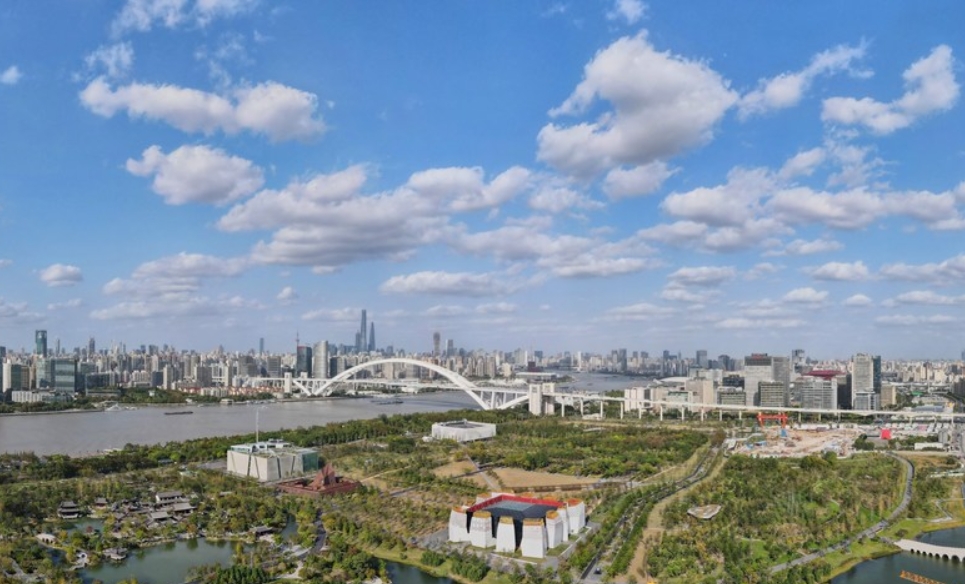From farmland to high-tech zone, Shanghai's Pudong mirrors China's modernization drive

This aerial photo taken on Oct. 17, 2022 shows a view of World Expo culture park at the China (Shanghai) Pilot Free Trade Zone in east China's Shanghai. (Xinhua/Fang Zhe)
At the latest edition of the China International Import Expo (CIIE), a remanufactured car engine was displayed at the booth of German carmaker Mercedes-Benz at an exhibition showcasing new technologies and products by companies based at the Lingang new area of the China (Shanghai) Pilot Free Trade Zone (FTZ) in Shanghai, east China.
Prior to that, the hectic Pudong International Airport also welcomed a remanufactured engine in September. This one, imported by Volvo Construction Equipment (China), was the first of its kind in China.
Both cases were made possible by the higher-level opening-up measures for China's FTZs and free ports released by the State Council in late June.
According to the measures, pilot programs for importing remanufactured products will be carried out in the FTZs or free ports.
"Compared to new products, remanufactured items can reduce energy consumption by 60 percent, and up to 70 percent of the materials can be recycled, thus, lowering carbon dioxide emissions by 80 percent," said Chen Chaoping, vice president of Volvo Construction Equipment (China).
The fresh move is just one of a slew of innovative approaches that support Pudong's reputation as the country's vanguard in pushing up reform and opening up.
Pudong's transformation is an embodiment of China's modernization drive over the past decades.
When designated a new area in 1990, Pudong was still a vast expanse of desolate farmland, noted Shao Yudong, then head of Pudong development office.
"The construction of infrastructure in Pudong, such as roads, bridges, water, electricity and sanitation facilities were also quite inadequate at that time," Shao added.
In September 2013, Pudong was chosen to host the country's first pilot FTZ, which play a vital role as test fields for institutional reform.
Over the past decade, Pudong accomplished a great many firsts with the implementation of a battery of bold attempts: The establishment of the country's first wholly foreign-owned hospital, the first wholly foreign-funded public fund company, the first wholly foreign-owned automobile manufacturing enterprise.
A number of pioneering projects, across 60 sectors such as automobile manufacturing, financial services, value-added telecommunications, testing and certification, have been cultivated in Pudong.
Official data shows that between September 2013 and 2022, Shanghai FTZ saw the establishment of 84,000 new enterprises, which is 2.35 times the number in the previous 20 years in the region.
During the same period, the area also welcomed more than 14,000 new foreign investment projects with a cumulative actual foreign investment of 58.6 billion U.S. dollars, which means every minute over 10,000 U.S. dollars of investment was injected into the Shanghai FTZ.
Today, Pudong is packed with gleaming skyscrapers and home to a cluster of state-of-the-art industries.
With only 1/8,000 of China's total land area, Pudong contributed 1/74 of the country's GDP, and has become a model for the rest of the country on how to launch reforms and achieve high-quality development in a new era.
As China moves toward its second centenary goal of fully building a modern socialist country, Pudong is also ushering in a new stage of development.
In 2021, China issued a guideline to support high-level reform and opening-up of Pudong and build the area into a pioneer of socialist modernization.
By 2050, Pudong is expected to become an important urban area that is highly attractive, creative, competitive and influential globally, a global model of urban governance and a "shining pearl" of a great modern socialist country, the guideline said.
In Lingang new area, a newly launched special area in Shanghai FTZ in August 2019, new industrial clusters are turning into fresh growth engines.
New energy vehicles (NEV), for example, has become a landmark industry in Lingang.
At Tesla's Shanghai gigafactory, it takes an average of just 40 seconds for a finished car to roll off the assembly line. In 2022, the annual output value of the NEV industry in Lingang new area exceeded 230 billion yuan (about 32 billion U.S. dollars).
Thanks to the solid industrial foundation and the support of preferential policies, the average annual growth of Lingang new area's GDP reached 21.2 percent over the past four years, and the average annual growth of industrial output value and fixed asset investment also logged remarkable growth rates of 37.8 percent and 39.9 percent, respectively.
In 2000, leading construction machine manufacturer Liebherr set up the first wholly foreign-owned enterprise in Pudong's Waigaoqiao. The company's growth gained further strength after the establishment of the Shanghai FTZ. In 2019, Liebherr settled its Chinese headquarters, incorporating a trading center, a distribution center and aviation maintenance business, in the Shanghai FTZ.
"We are honored to grow together with the Shanghai FTZ. We also appreciate the support provided by the FTZ. In the future, we will continue to adhere to the principle of 'based in Shanghai serving China', and introduce German most advanced machinery manufacturing technology into China," said Patrick Schulz, general manager of Liebherr China.
Editor:伏娅敏
